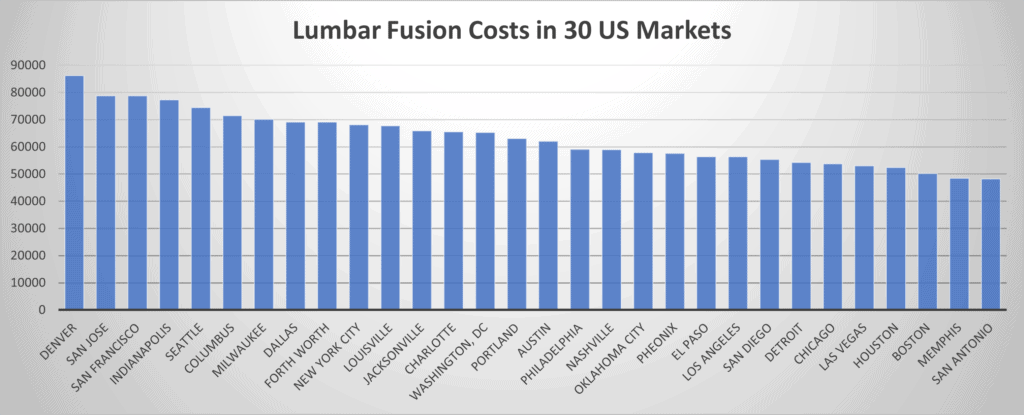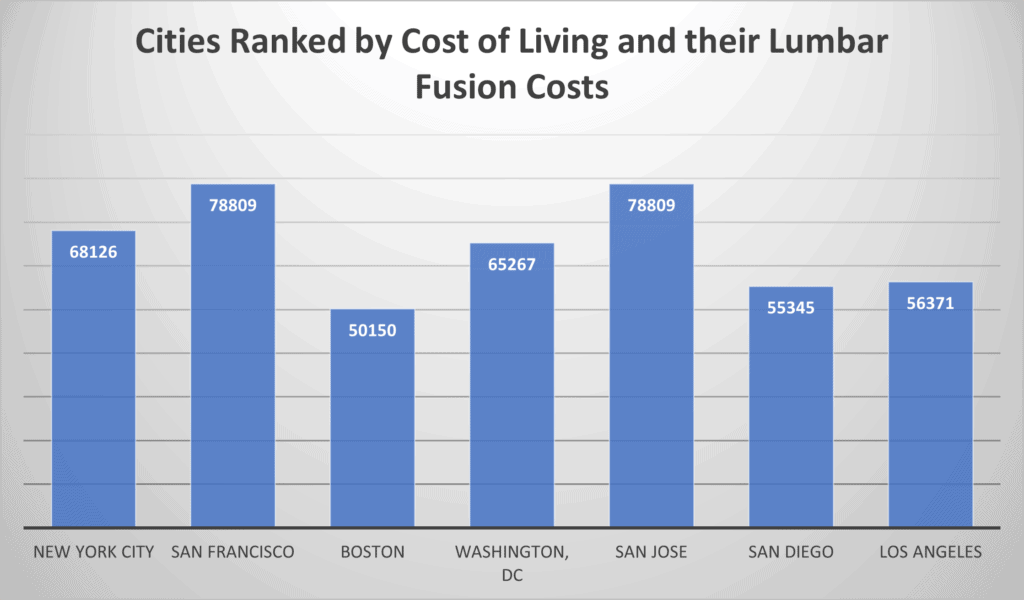How Much Does Low Back Fusion Cost?

One of the most costly and common back surgeries out there is Low Back Fusion. Today we’ll explore the question, “How much does Low Back Fusion cost?”. The answer is that it all depends on where you live. Let’s dig in.
What Is Low Back Fusion?

Credit: Shutterstock
Low Back or Lumbar Fusion is a procedure where hardware is commonly installed to prevent movement of the spine. The spinal discs are also “fused” together either with bone or a piece of hardware inserted into the disc space. While the procedure is common, it’s dramatically overused. I would estimate from what I observe that approximately 80-90% of the patients who get this procedure don’t need it with about 1-2 in 10 patients having no other option.
Say Hello to My Little Friend, ASD
The problem with Spinal Fusion is that when you stop the motion of certain spinal segments that energy must go somewhere. Where does it go? It goes to the adjacent segments, often breaking these down. This happens so often in fact, there’s a name for it: “Adjacent Segment Disease” or ASD. To learn more about ASD, see my video below:
Is Fusion Smart or Dumb Medicine?
Surely, the additional invasiveness of banging in screws, rods, and plates must come with additional benefits to offset the risk? While that would make sense, the research data points in the opposite direction (1-3). By adding a Fusion, surgeons are picking up risk without any clinical benefit.
How Much Does Fusion Cost?
Medical costs are often a mystery. For example, we generally know what a TV costs. In addition, we all know that professional and other specialized labor costs vary with experience, name recognition, and the cost of the market. For example, an attorney in New York City can almost always charge more than one in a small rural town. However, insurance-covered medical costs are strange in that they often seem to bend these rules. If there ever was a way to see just how crazy our medical care system is with regard to how much your insurance pays for things, Lumbar Fusion is a great way to see that insanity.
First, as shown at the top of the article, I graphed the cost of Lumbar Fusion from a recent Healthcare Bluebook report (4). Note the crazy wide variation of costs that range from a low of 48K in San Antonio to a high of 86K in Denver! How does that stack up against the cost of living in various cities?

Directly above, I ordered the cities above by their cost of living as shown above with New York being the most expensive. As you can see, there is zero relationship between the cost of living and Lumbar Fusion costs. For example, New York should be the most expensive to get a Low Back Fusion, but it clocks in at #10. Denver’s highest cost is despite that city being #12 on the cost of living list. Also, note that Indianapolis often appears in the cheapest cities to live list (#12 cheapest), but is in the number 4 slot for the most expensive Lumbar Fusion.
What’s Driving These Costs?
If I look at my home market of Denver, what makes it different? One of the things could be hospital consolidation. Our market is now controlled by a few giant hospital systems that all compete for Spine Surgeons. Meaning insurers have few choices when it comes to contracting as most surgeons are tied to one hospital system or another. However, that’s also happening in other healthcare markets and is a trend that accelerated with Obamacare. So what else could it be?
Another unique thing about Denver is the ease with which one can open an ambulatory surgery center. In many states like New York and others, this requires a Certificate of Need from the state. Meaning that you need to show that your surgery center is needed by the community. In Colorado, no Certificate of Need is needed. In addition, in Denver, to survive, all of those surgery centers have joined forces with one of the hospital monopolies discussed above.
Finally, in Denver, we have the rise of Orthopedic specialty hospitals and supergroups. Meaning the surgeons have almost all joined one of only a handful of huge Orthopedic groups that are tied to the above hospital monopolies. That creates even less competition for insurance contracting, causing the supergroup to be able to name their price when United Healthcare comes knocking.
Therefore, our crazy high price is likely due to an intersection of all three of these phenomena reducing competition in our market. That hopefully gives you some insight in how insurance costs work. They often have nothing to do with real costs like paying employees more in New York City and everything to do with how our healthcare systems have worked to stifle competition.
Interventional Orthobiologics vs. Fusion
We’ve been successful in getting Orthobiologics like PRP and Bone Marrow Concentrate covered through specific Employer Health Plans because of the ridiculous cost and poor value proposition of surgeries like Lumbar Fusion. Our costs have generally been 40-50% cheaper to help patients avoid this surgery through precise injections of Orthobiologics. We are in the process of formalizing those cost savings working with a university healthcare economics group that I’ll soon highlight on this blog.
However, this blog brings up a problem. Trying to just push Orthopedic groups down on price will never move the cost needle. Why? As the Denver market shows, these groups just zig when the insurance company zags. Meaning that the rise of market consolidation across the US will push rates up and not down. The only way to reduce Orthopedic costs is to perform an end-around on Orthopedic groups. That’s what we do at Regenexx by offering procedures that compete head to head in the marketplace with Orthopedic surgery. We also move those procedures from costly ambulatory surgery centers into physician offices. That all provides a financial incentive to dismantle the surgical oligarchy.
The upshot? Fusion is expensive and has poor outcomes with costs that reflect more the insanity of insurance contracting and our nutty healthcare system. If we want to bend the cost curve down on expensive and invasive Orthopedic surgeries, the answers will be found outside of the Orthopedic groups who are trying hard to keep their prices as high as possible.
_____________________________________________
References:
(1) Maruenda JI, Barrios C, Garibo F, Maruenda B. Adjacent segment degeneration and revision surgery after circumferential lumbar fusion: outcomes throughout 15 years of follow-up. Eur Spine J. 2016 May;25(5):1550-1557. doi: 10.1007/s00586-016-4469-5. Epub 2016 Mar 8. PMID: 26957098.
(2) Nguyen TH, Randolph DC, Talmage J, Succop P, Travis R. Long-term outcomes of lumbar fusion among workers’ compensation subjects: a historical cohort study. Spine (Phila Pa 1976). 2011 Feb 15;36(4):320-31. doi: 10.1097/BRS.0b013e3181ccc220. PMID: 20736894.
(3) Wang X, Wanyan P, Tian JH, Hu L. Meta-analysis of randomized trials comparing fusion surgery to non-surgical treatment for discogenic chronic low back pain. J Back Musculoskelet Rehabil. 2015;28(4):621-7. doi: 10.3233/BMR-140571. PMID: 25467996.
(4) Beckers Spine Review. Cost of lumbar spinal fusion in the 30 biggest US cities. https://www.beckersspine.com/spine/item/53684-cost-of-lumbar-spinal-fusion-in-the-30-biggest-us-cities.html?utm_medium=email&utm_content=newsletter Accessed 2/27/22
https://www.beckersspine.com/spine/item/53684-cost-of-lumbar-spinal-fusion-in-the-30-biggest-us-cities.html?utm_medium=email&utm_content=newsletter

If you have questions or comments about this blog post, please email us at [email protected]
NOTE: This blog post provides general information to help the reader better understand regenerative medicine, musculoskeletal health, and related subjects. All content provided in this blog, website, or any linked materials, including text, graphics, images, patient profiles, outcomes, and information, are not intended and should not be considered or used as a substitute for medical advice, diagnosis, or treatment. Please always consult with a professional and certified healthcare provider to discuss if a treatment is right for you.